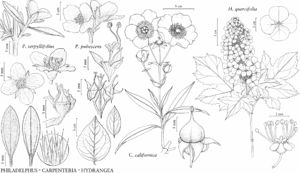Difference between revisions of "Philadelphus pubescens"
Herb. Gén. Amat. 4: 268. 1820.
FNA>Volume Importer |
FNA>Volume Importer |
||
| Line 19: | Line 19: | ||
|name=Philadelphus gattingeri | |name=Philadelphus gattingeri | ||
|authority=S. Y. Hu | |authority=S. Y. Hu | ||
| − | }}{{Treatment/ID/Synonym | + | }} {{Treatment/ID/Synonym |
|name=P. intectus | |name=P. intectus | ||
|authority=Beadle | |authority=Beadle | ||
| − | }}{{Treatment/ID/Synonym | + | }} {{Treatment/ID/Synonym |
|name=P. intectus var. pubigerus | |name=P. intectus var. pubigerus | ||
|authority=S. Y. Hu | |authority=S. Y. Hu | ||
| − | }}{{Treatment/ID/Synonym | + | }} {{Treatment/ID/Synonym |
|name=P. latifolius | |name=P. latifolius | ||
|authority=Schrader | |authority=Schrader | ||
| − | }}{{Treatment/ID/Synonym | + | }} {{Treatment/ID/Synonym |
|name=P. pubescens var. intectus | |name=P. pubescens var. intectus | ||
|authority=(Beadle) A. H. Moore | |authority=(Beadle) A. H. Moore | ||
| − | }}{{Treatment/ID/Synonym | + | }} {{Treatment/ID/Synonym |
|name=P. pubescens var. verrucosus | |name=P. pubescens var. verrucosus | ||
|authority=(Schrader) S. Y. Hu | |authority=(Schrader) S. Y. Hu | ||
| − | }}{{Treatment/ID/Synonym | + | }} {{Treatment/ID/Synonym |
|name=P. verrucosus | |name=P. verrucosus | ||
|authority=Schrader | |authority=Schrader | ||
| Line 52: | Line 52: | ||
|elevation=0–1000 m. | |elevation=0–1000 m. | ||
|distribution=Ont.;Ala.;Ark.;Conn.;Ga.;Ill.;Iowa;Kans.;Ky.;La.;Md.;Mass.;Mich.;Miss.;Mo.;N.Y.;Ohio;Okla.;Tenn.;Tex.;Va.;Wyo. | |distribution=Ont.;Ala.;Ark.;Conn.;Ga.;Ill.;Iowa;Kans.;Ky.;La.;Md.;Mass.;Mich.;Miss.;Mo.;N.Y.;Ohio;Okla.;Tenn.;Tex.;Va.;Wyo. | ||
| − | |discussion=<p>Philadelphus pubescens is cultivated beyond its native range, which is believed to have been Alabama, Arkansas, Georgia, Illinois, Kentucky, Louisiana, Mississippi, Missouri, Oklahoma, Tennessee, and Texas; it is considered introduced in the remaining places listed.</p> | + | |discussion=<p><i>Philadelphus pubescens</i> is cultivated beyond its native range, which is believed to have been Alabama, Arkansas, Georgia, Illinois, Kentucky, Louisiana, Mississippi, Missouri, Oklahoma, Tennessee, and Texas; it is considered introduced in the remaining places listed.</p> |
|tables= | |tables= | ||
|references= | |references= | ||
| Line 76: | Line 76: | ||
|publication year=1820 | |publication year=1820 | ||
|special status=Selected by author to be illustrated;Endemic | |special status=Selected by author to be illustrated;Endemic | ||
| − | |source xml=https://jpend@bitbucket.org/aafc-mbb/fna-data-curation.git/src/ | + | |source xml=https://jpend@bitbucket.org/aafc-mbb/fna-data-curation.git/src/8f726806613d60c220dc4493de13607dd3150896/coarse_grained_fna_xml/V12/V12_1051.xml |
|genus=Philadelphus | |genus=Philadelphus | ||
|species=Philadelphus pubescens | |species=Philadelphus pubescens | ||
Revision as of 14:43, 18 September 2019
Shrubs, 10–65 dm. Stems erect to ascending, green, older stems gray, glabrous or sparsely strigose or villous, especially at nodes; bark tight, not exfoliating or flaking, gray; branches erect; axillary buds hidden in pouches. Leaves: petiole 1–12(–20) mm; blade broadly lanceolate to broadly ovate, or narrowly to broadly elliptic, (3–)5–10(–16) × 1.6–7(–11) cm, base narrowly cuneate to rounded, margins entire or irregularly to regularly serrate, crenate, or dentate, plane, abaxial surface moderately to densely strigose or tomentose to villous, hairs twisted, main vein axils and main veins often more densely strigose-tomentose, adaxial surface glabrous or very sparsely strigose, especially near base and margins. Inflorescences usually cymose racemes or cymose panicles, sometimes flowers solitary, (1–)5–9-flowered, proximal 2 or 4 flowers often in axils of nearly normal to much reduced (bracteal) leaves. Pedicels 3–8 mm, glabrous or moderately strigose. Flowers: hypanthium sparsely to densely strigose or villous; sepals ovate, ovate-lanceolate, or triangular, 5–8 × 3–5 mm, apex acute to acuminate, abaxial surface moderately to densely strigose or villous, adaxial surface densely villous distally; petals white, oblong, obovate, or orbiculate, 12–21 × 8–12 mm; stamens 25–50; filaments distinct, 5–11 mm; anthers 1.5 × 1 mm; styles 4, connate proximally, cylindric, 6–10 mm, lobes 1.5–5 × 0.4–0.7 mm; stigmatic surfaces 1.5–4 mm. Capsules obconic to obovoid, 6–11 × 4–7 mm. Seeds caudate, 3–4 mm. 2n = 26.
Phenology: Flowering May–Jul; fruiting Jun–Oct.
Habitat: Cliffs, rock outcrops, bluffs, rocky slopes, old homesites, suburban woodlands, stream banks.
Elevation: 0–1000 m.
Distribution

Ont., Ala., Ark., Conn., Ga., Ill., Iowa, Kans., Ky., La., Md., Mass., Mich., Miss., Mo., N.Y., Ohio, Okla., Tenn., Tex., Va., Wyo.
Discussion
Philadelphus pubescens is cultivated beyond its native range, which is believed to have been Alabama, Arkansas, Georgia, Illinois, Kentucky, Louisiana, Mississippi, Missouri, Oklahoma, Tennessee, and Texas; it is considered introduced in the remaining places listed.
Selected References
None.
